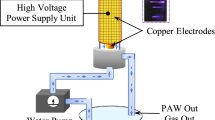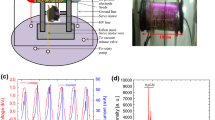Abstract
This paper reports the stimulation of wheat seedling growth by using plasma-treated water. A nanosecond pulsed generator in a gas bubble-in-liquid system with a point-to-plate electrode was employed to treat de-ionised (DI) water, producing mainly hydrogen peroxide (H2O2) in the water when argon gas was used, and nitrate (\({\text{NO}}_{3}^{ - }\)) when air was used. The H2O2 and \({\text{NO}}_{3}^{ - }\) generated, respectively, in argon and air plasma-treated water significantly increased the growth parameters such as biomass, leaf length, and the relative chlorophyll content of the wheat seedling. The total biomass of the seedlings grown in potting mix after 4 weeks was augmented by 61 and 87%, respectively, for argon plasma-treated water and air plasma-treated water compared with the control (untreated DI water). In hydroponics, the biomass of the seedling increased 27 and 38%, respectively, for the argon and the air after 2 weeks in comparison to the control. In potting mix, the shoots and roots of the seedlings responded differently to the treated water: the biomass of shoot increased 33% for air plasma-treated water compared with the argon, while that of root increased 17% for argon plasma-treated water compared with the air. A separate experiment in hydroponics with chemical solutions of H2O2 and \({\text{NO}}_{3}^{ - }\) matching with the concentrations of the H2O2 and \({\text{NO}}_{3}^{ - }\) generated in the plasma-treated water showed similar stimulation of wheat seedling growth.






Similar content being viewed by others
References
Bruggeman P, Leys C (2009) Non-thermal plasmas in and in contact with liquids. J Phys D Appl Phys 42:053001
Dai XJ, Corr CS, Ponraj SB, Maniruzzaman M, Ambujaksan AT, Chen Z, Kviz L, Lovett R, Rajmohan GD, de Celis DR, Wright ML, Lamb PR, Krasik YE, Graves DB, Graham WG, d’Agostino R, Wang X (2016) Efficient and selectable production of reactive species using a nanosecond pulsed discharge in gas bubbles in liquid. Plasma Process Polym 13:306–310
Brisset J-L, Hnatiuc E (2012) Peroxynitrite: a re-examination of the chemical properties of non-thermal discharges burning in air over aqueous solutions. Plasma Chem Plasma Process 32:655–674
Locke BR, Sato M, Sunka P, Hoffman MR, Chang J-S (2006) Electrohydraulic discharge and nonthermal plasma for water treatment. Ind Eng Chem Res 45:882–905
Lukes P, Dolezalova E, Sisrova I, Clupek M (2014) Aqueous-phase chemistry and bactericidal effects from an air discharge plasma in contact with water: evidence for the formation of peroxynitrite through a pseudo-second-order post-discharge reaction of H2O2 and HNO2. Plasma Sources Sci Technol 23:015019
Du Y, Nayak G, Oinuma G, Peng Z, Bruggemen PJ (2017) Effect of water vapor on plasma morphology, OH and H2O2 production in He and Ar atmospheric pressure dielectric barrier discharges. J Phys D Appl Phys 50:145201
Chen Z, Cheng X, Lin L, Keidar M (2017) Cold atmospheric plasma discharged in water and its potential use in cancer therapy. J Phys D Appl Phys 50:015208
Andrews M, Raven JA, Lea PJ (2013) Do plants need nitrate? The mechanisms by which nitrogen form affects plants. Ann Appl Biol 163:174–199
Hawkesford M, Horst W, Kichey T, Lambers H, Schjoerring J, Møller IS (2012) Functions of macronutrients: Marschner’s mineral nutrition of higher plants. Academic Press, San Diego
Miller AJ, Fan X, Orsel M, Smith SJ, Wells DM (2007) Nitrate transport and signalling. J Exp Bot 58:2297–2306
Krapp A, David LC, Chardin C, Girin T, Marmagne A, Leprince A-S (2014) Nitrate transport and signalling in Arabidopsis. J Exp Bot 65:789–798
Alboresi A, Gestin C, Leydecker MT, Bedu M, Meyer C, Truong HN (2005) Nitrate, a signal relieving seed dormancy in Arabidopsis. Plant Cell Environ 28:500–512
Walch-Liu P, Neumann G, Bangerth F, Engels C (2000) Rapid effects of nitrogen form on leaf morphogenesis in tobacco. J Exp Bot 51:227–237
Wang RC, Guegler K, LaBrie ST, Crawford NM (2000) Genomic analysis of a nutrient response in Arabidopsis reveals diverse expression patterns and novel metabolic and potential regulatory genes induced by nitrate. Plant Cell 12:1491–1509
Quan LJ, Zhang B, Shi WW, Li HY (2008) Hydrogen peroxide in plants: a versatile molecule of the reactive oxygen species network. J Integr Plant Biol 50:2–18
Saxena I, Srikanth S, Chen Z (2016) Cross talk between H2O2 and interacting molecules under plant stress response. Front Plant Sci 7:570
Halliwell B (2006) Reactive species and antioxidants. Redox biology is a fundamental theme of aerobic life. Plant Physiol 141:312–322
Shetty NP, Jorgensen HJL, Jensen JD, Collinge DB, Shetty HS (2008) Roles of reactive oxygen species in interactions between plants and pathogens. Eur J Plant Pathol 121:267–280
Barba-Espin G, Diaz-Vivancos P, Clemente-Moreno MJ, Albacete A, Faize L, Faize M (2010) Interaction between hydrogen peroxide and plant hormones during germination and the early growth of pea seedlings. Plant Cell Environ 33:981–994
Li J-T, Qiu Z-B, Zhang X-W, Wang L-S (2011) Exogenous hydrogen peroxide can enhance tolerance of wheat seedlings to salt stress. Acta Physiol Plant 33:835–842
Fedina IS, Nedeva D, Cicek N (2009) Pre-treatment with H2O2 induces salt tolerance in barley seedlings. Biol Plant 53:321–324
Hameed A, Farooq S, Iqbal N, Arshad R (2004) Influence of exogenous application of hydrogen peroxide on root and seedling growth on wheat (Triticum aestivum L.). Int J Agric Biol 6:366–369
Stoffels E, Sakiyama Y, Graves DB (2008) Cold atmospheric plasma: charges species and their interactions with cells and tissues. IEEE Trans Plasma Sci 36:1441–1457
Jiafeng J, Xin H, Ling L, Jiangang L (2014) Effect of cold plasma treatment on seed germination and growth of wheat. Plasma Sci Technol 16:54–58
Sera B (2010) Influence of plasma treatment on wheat and oat germination and early growth. IEEE Trans Plasma Sci 38:2963–2968
Misra NN, Patil S, Moiseev T, Bourke P, Mosnier JP, Keener KM (2014) In-package atmospheric pressure cold plasma treatment of strawberries. J Food Eng 125:131–138
Henselová M, Slováková Ľ, Martinka M, Zahoranová A (2012) Growth, anatomy and enzyme activity changes in maize roots induced by treatment of seeds with low-temperature plasma. Biologia 67:490–497
Bormashenko E, Grynyov R, Bormashenko Y, Drori E (2012) Cold radiofrequency plasma treatment modifies wettability and germination speed of plant seeds. Sci Rep 2:741
Takaki K, Takahata J, Watanabe S, Satta N, Yamada O, Fujio T (2013) Improvements in plant growth rate using underwater discharge. J Phys Conf Ser 418:012140
Park DP, Davis K, Gilani S, Alonzo C-A, Dobrynin D, Friedman G (2013) Reactive nitrogen species produced in water by non-equilibrium plasma increase plant growth rate and nutritional yield. Curr Appl Phys 13:19–29
Lindsay A, Byrns B, King W, Andhvarapou A, Fields J, Knappe D (2014) Fertilization of radishes, tomatoes, and marigolds using a large-volume atmospheric glow discharge. Plasma Chem Plasma Process 34:1271–1290
Eisenberg GM (1943) Colorimetric determination of hydrogen peroxide. Ind Eng Chem Anal Ed 15:327–328
Gunning T, Cahill DM (2009) A soil-free plant growth system to facilitate analysis of plant pathogen interactions in roots. J Phytopathol 157:497–501
Tyler G (2004) Rare earth elements in soil and plant systems—a review. Plant Soil 267:191–206
Acknowledgements
Thank you to Dr Hashmath Hussain for the initial discussions on this project. MM was the recipient of a Deakin University Postgraduate Research Scholarship.
Author information
Authors and Affiliations
Corresponding author
Rights and permissions
About this article
Cite this article
Maniruzzaman, M., Sinclair, A.J., Cahill, D.M. et al. Nitrate and Hydrogen Peroxide Generated in Water by Electrical Discharges Stimulate Wheat Seedling Growth. Plasma Chem Plasma Process 37, 1393–1404 (2017). https://doi.org/10.1007/s11090-017-9827-5
Received:
Accepted:
Published:
Issue Date:
DOI: https://doi.org/10.1007/s11090-017-9827-5




